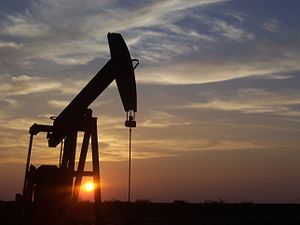This article needs additional citations for verification. (December 2023) |

An oil well is a drillhole boring in Earth that is designed to bring petroleum oil hydrocarbons to the surface. Usually some natural gas is released as associated petroleum gas along with the oil. A well that is designed to produce only gas may be termed a gas well. Wells are created by drilling down into an oil or gas reserve and if necessary equipped with extraction devices such as pumpjacks. Creating the wells can be an expensive process, costing at least hundreds of thousands of dollars, and costing much more when in difficult-to-access locations, e.g., offshore. The process of modern drilling for wells first started in the 19th century but was made more efficient with advances to oil drilling rigs and technology during the 20th century.
Wells are frequently sold or exchanged between different oil and gas companies as an asset – in large part because during falls in the price of oil and gas, a well may be unproductive, but if prices rise, even low-production wells may be economically valuable. Moreover, new methods, such as hydraulic fracturing (a process of injecting gas or liquid to force more oil or natural gas production) have made some wells viable. However, peak oil and climate policy surrounding fossil fuels have made fewer of these wells and costly techniques viable.
However, a large number of neglected or poorly maintained wellheads is a large environmental issue: they may leak methane or other toxic substances into local air, water and soil systems. This pollution often becomes worse when wells are abandoned or orphaned – i.e., where wells no longer economically viable are no longer maintained by their (former) owners. A 2020 estimate by Reuters suggested that there were at least 29 million abandoned wells internationally, creating a significant source of greenhouse gas emissions worsening climate change.[1][2]
- ^ Groom N (2020-06-17). "Special Report: Millions of abandoned oil wells are leaking methane, a climate menace". Reuters. Retrieved 2021-04-07.
- ^ Geller D (13 July 2020). "More Exposures from Abandoned Oil and Gas Wells Come Into Focus". Verisk.